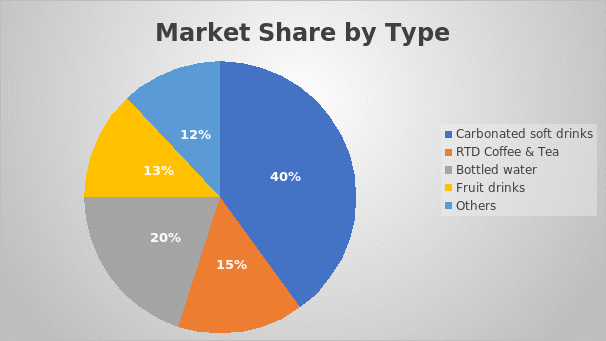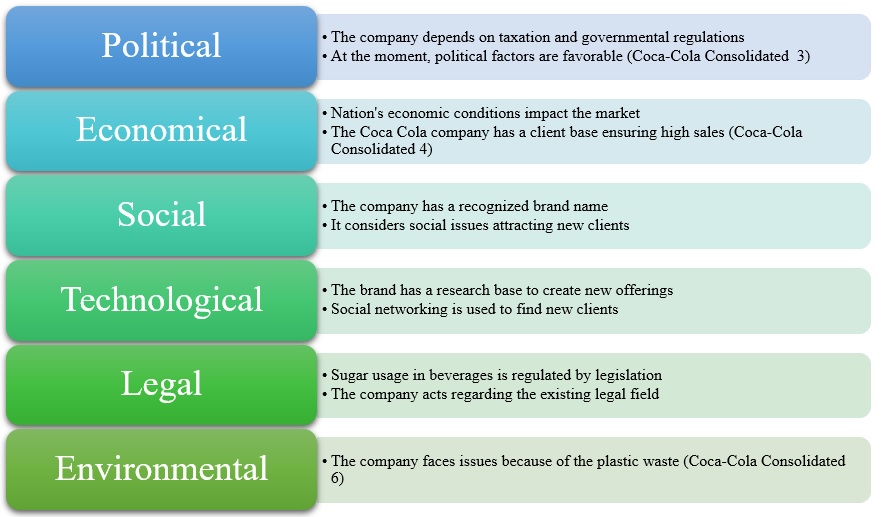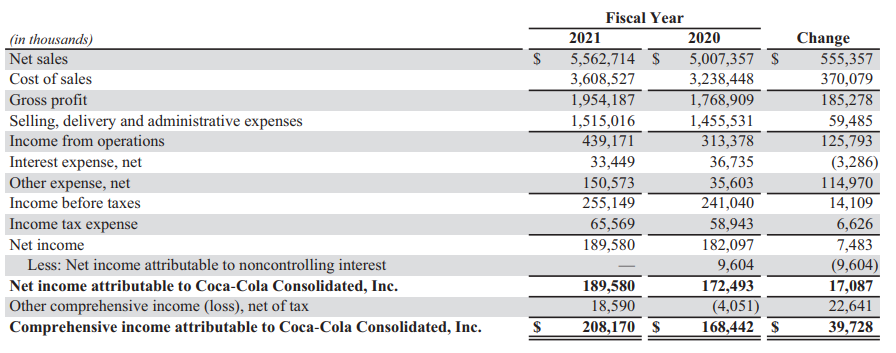Introduction
The functioning of any company is a complex and continuous process depending on multiple factors. The degree to which they are considered and managed stipulates the firm’s success, ability to evolve and struggle against rivals. The top management must consider the industry’s current state, major competitors, and existing demand to create the basis for the future company’s rise. For this reason, it might be a complex task requiring competencies and relevant knowledge. Thus, the current report is devoted to investigating the Coca-Cola company. It delves into the most important aspects of its functioning, industry analysis, and evaluation of financial outcomes to acquire a clear vision of how the company evolves and why it remains one of the leaders in the selected market sphere. At the same time, some recommendations regarding the acquired information will be given.
Company’s Background
The Coca-Cola Company is the modern leader in the non-alcoholic beverages industry. Currently, it sells products in around 200 countries across the globe (“About the Coca Cola Company”). It produces and distributes iconic goods such as Coca-Cola, Sprite, and Fanta, which have become a part of the popular culture (“About the Coca-Cola company”). For this reason, it has a broad target audience and stable income. Its recent annual report shows that in 2020, its net revenues comprised $9.5 billion, which is 10% higher than in the previous year (The Coca-Cola Company, “Form 10-K” 14). The company acquired $38.7 billion in revenues in the full year (The Coca-Cola Company, “Form 10-K” 13). It indicates the firm’s strong position in the market and the success of its current strategy. Furthermore, the company operates in different regions, interacting with clients with multiple cultures (The Coca-Cola Company, “Form 10-K” 14). In 2021, the company created jobs for about 79,000 employees in various countries (“About the Coca-Cola company”). For this reason, it can be viewed as one of the leaders in the sphere with excellent chances for continuous evolution.
Industry Analysis
The Coca-Cola Company operates in an attractive and highly competitive industry. Thus, following the official report, the global non-alcoholic beverages market size was evaluated as $919.13 billion (“Non-alcoholic Beverages Market Size”). It is also forecasted to continue to grow and reach $1,257.77 billion by 2027 (“Non-alcoholic Beverages Market Size”). At the moment, various types of drinks comprise the overall market share:

In such a way, the carbonated soft drinks comprise the biggest share, guaranteeing the highest and most stable income. Coca-Cola is at the moment the leader of the industry as it produces products comprising the biggest market shares, such as carbonated drinks, bottled water, and coffee and tea (“Non-alcoholic Beverages Market Size”). At the same time, there are also some powerful corporations working in the same segment, such as PepsiCo, Danone, Nestle, and AriZona Beverages (“Non-alcoholic Beverages Market Size”). In such a way, the market remains highly competitive and attractive for numerous actors, as it provides opportunities for stable income.
PESTLE Analysis
The PESTLE analysis tool can also be used to evaluate the influence of external factors on the company’s work.

Altogether, the analysis shows that the company’s positions are stable, and it has numerous opportunities to evolve; however, it is vital to address the environmental aspect of its functioning to ensure the problem of plastic waste is addressed and managed effectively.
Competition
Analyzing the Coca-Cola company’s work, it is also vital to admit the high level of competition peculiar to the segment. The non-alcoholic beverages market is a highly attractive sphere with stable income. The nature of sold goods implies that there will always be a demand for bottled water, carbonated drinks, and fruit drinks (“Non-alcoholic Beverages Market Size”). In such a way, it creates the basis for the high risk of the new entry and emergence of smaller brands trying to find their loyal audience. At the same time, there are other more significant players, such as PepsiCo, Danone, and Nestle, which contribute to the growing competition in the sphere. For this reason, Coca-Cola views the necessity to generate a competitive advantage as a part of its strategy (The Coca-Cola Company, “Our Business Strategy” 2). The brand focuses on creating a recognizable name, advertising campaigns, and cooperation with celebrities as the method to popularize its products (The Coca-Cola Company, “Our Business Strategy” 2). It helps to preserve leading positions in the segment and evolve.
Major Rivals
The Coca-Cola Company also emphasizes the necessity to overcome its rivals. One of the significant issues supporting the fierce rivalry is the similarity of tastes offered by giant corporations. For instance, Coca-Cola is opposed by Pepsi, Fanta by Mirinda, and Sprite by 7up (Coca-Cola Consolidated 4). The products have numerous similarities with slight differences that might not be recognized by an inexperienced consumer (Coca-Cola Consolidated 4). Under these conditions, the opposition between the major rival becomes stronger. Coca-Cola emphasizes the unique taste of all its products compared to others and their unusual character (Coca-Cola Consolidated 5). It is a part of its strategy to overcome rivals and continue broadening its target audience. At the same time, significant resources are devoted to research to introduce new tastes and ensure they might attract new clients from various regions.
SWOT Analysis
Strengths
The strong position of the Coca-Cola company in the international market can be explained by the competitive advantage it possesses and the firm’s significant strengths. First of all, the corporation has a unique brand identity and is popular in all regions across the globe, which promotes its becoming a part of the popular culture (Coca-Cola Consolidated 11). Coca-Cola achieved a critical milestone by making its products the most selling beverages in the history (Coca-Cola Consolidated 3). Furthermore, the brand has a high brand value of $57 billion, making it the sixth-best global company (Coca-Cola Consolidated 4). It helps to compete with the closest rivals and use available resources to attain current goals. The company works in 200 countries and makes 1.9 billion servings per day (Coca-Cola Consolidated 11). It helps to acquire the biggest market share in the industry comprising 3.2% of all servings (Coca-Cola Consolidated 7). Finally, the company has a developed distribution system supported by skilled employees (“Our Culture”). These strengths create the basis for the future company’s rise.
Weaknesses
At the same time, the company has several problems and critical issues influencing its development. First, the market is characterized by fierce rivalry, and several global corporations, such as Pepsi, Danone, and Nestle, are struggling for dominance (Coca-Cola Consolidated 4). Furthermore, Coca-Cola lacks diversity in its products and offerings. Its most iconic and recognizable beverages remain popular; however, new products are needed to preserve the high level of customer interest (Coca-Cola Consolidated 3). The company is also one of the greatest pollutants and plastic waste producers, impacting its image (Coca-Cola Consolidated 5). At the same time, the growing level of health awareness in clients influences sales as carbonated drinks and sugar are linked to obesity issues (Coca-Cola Consolidated 3). Under these conditions, Coca-Cola has some weaknesses and problems that should be considered to ensure it remains one of the leaders in the sphere.
Opportunities
Furthermore, the change in clients’ demands and the current market state offer several important opportunities for the company. First of all, Coca-Cola has started to diversify its products, which is a chance to broaden the target audience and acquire new benefits (Coca-Cola Consolidated 5). Second, the brand introduced new products, such as healthy drinks, which offer an opportunity to enter a new market segment and influence customers concerned about their health and food intake (Coca-Cola Consolidated 7). As a result, the brand demonstrates stable growth in this sphere and changes its image. Finally, Coca-Cola focuses on making new acquisitions to diversify its products and acquire new production facilities, which are vital for its future rise. In such a way, the corporation has numerous opportunities to preserve its leading positions in the segment.
Threats
The high level of rivalry, environmental issues, and health consciousness are the three major threats critical for the Coca-Cola company. Research performed by the corporation shows that the level of clients buying traditional beverages, such as Coca-Cola, reduced (Coca-Cola Consolidated 3). It means that the individuals choose healthier products. At the same time, the use of plastic bottles as the main package gives rise to environmental concerns and numerous claims against the company. Moreover, the brand’s image also suffers from the lack of sustainable efforts, meaning that clients might disregard the company or cooperate with other firms. Economic instability might also impact the brand, reducing the clients’ buying power and their readiness to cooperate with companies (Coca-Cola Consolidated 6). Combined with the constantly growing rivalry, these factors become a severe threat to further development and require specific measures and responses to ensure the brand can evolve and avoid a severe decline in income level.
The following figure presents the results of the SWOT analysis:

Strategies
The effectiveness of the strategy used by the Coca-Cola Company is evidenced by its ability to preserve leading positions for an extended period. It means that the decision-making considers the current opportunities and threats and focuses on new incentives helping to eliminate weaknesses. First of all, Coca-Cola views the cultivation of diversity of its products as the primary task (The Coca-Cola Company, “Our Business Strategy” 3). Considering new tendencies, such as health consciousness and the popularity of sports, it opens new lines producing drinkable water and coffee (The Coca-Cola Company, “Our Business Strategy” 2). It allows the brand to struggle with rivals and enter new markets. Another critical aspect of the brand’s strategy is focusing on sustainability and corporate culture (The Coca-Cola Company, “Our Business Strategy” 4). Coca-Cola realizes the importance of human resources and the role employees play in the company’s rise. For this reason, it cultivates an influential corporate culture with high-performance teams and skilled workers (The Coca-Cola Company, “Our Business Strategy” 3). It helps to boost the brand’s effectiveness and invest in the company’s future. At the same time, sustainability efforts are introduced to manage harm done by plastic waste and improve the brand’s image, which is vital for the success of the marketing efforts.
Another essential part of the company’s strategy is promoting the brand’s iconic image. Coca-Cola puts much effort into making its beverages a part of popular culture. For this reason, its advertising campaigns are focused on engaging celebrities, outstanding sportsmen, singers, or restaurant chains (The Coca-Cola Company, “Our Business Strategy” 2). It leads to the creation of a recognizable company’s image, and its becoming one of the global leaders in the segment. The marketing efforts also emphasize the unique taste of the company’s products to ensure rivals are excelled and most clients remain loyal (The Coca-Cola Company, “Our Business Strategy” 3). It guarantees a high income and the corporation’s ability to evolve.
Financial Results
The company’s financial results also evidence the success and effectiveness of its strategy. Thus, the Coca-Cola company’s report shows that in 2021, its net sales comprised $5,6 billion ($5,562,714), which is 11% up compared to the 2020 fiscal year, when net sales comprised $5 billion (see Figure 4) (Coca-Cola Consolidated 38). Moreover, in 2019, the net sales were $4,9 billion, proving the stable growth (The Coca-Cola Company. “2019 Business & Sustainability Report” 34). Comprehensive income attributable to the brand also grew in 2021 and comprised $208,170 (Coca-Cola Consolidated 38). The numbers evidence that the company managed to recover from the crisis linked to the COVID 19 pandemic (Coca-Cola Consolidated 38).

The growth in the number of sold still beverages is one of the success factors explaining the rise in net sales. In 2021, the company sold 112,007 drinks of this sort, which is 6.2% higher than in 2020, with 105,423 items sold (see the figure). In 2019, only around 100,000 items were sold, which proves the tendency towards the increase in sales (The Coca-Cola Company. “2019 Business & Sustainability Report” 34). At the same time, there is no significant difference in sparkling beverages sales during the three years term. It means that the strategy aimed at diversifying the products is effective.

Recommendations
It is possible to offer specific recommendations on how the company should behave in the future regarding the acquired information. First of all, it is critical to preserve the focus on the diversification of beverages. The change in clients’ mentality introduces new opportunities for entering new market segments (Cummings and Worley 65). The 6.2% increase in still beverages sales proves that this strategy might be effective. For this reason, it is critical to design new tastes and drinks regarding the current clients’ demands and introduce them to the market. Another critical recommendation is to consider environmental and sustainability issues (Cummings and Worley 65). The brand should look for new packages for its beverages as plastic bottles cause critical harm to the environment. It will promote the brand’s image and help to avoid new claims or fines because of the violation of existing regulations.
Conclusion
Altogether, the Coca-Cola Company is one of the leaders in the sphere of non-alcoholic beverages nowadays. It has a developed infrastructure, numerous products, and a loyal target audience ready to buy proposed drinks. The company’s financial results also evidence the success of the employed strategy, which aims to diversify the product line and support the brand’s iconic image. At the same time, SWOT analysis shows that the company suffers from some sustainability problems, rivalry, and changes in client mentality. For this reason, it is recommended to continue diversifying the product line and introduce new beverages to meet the population’s changing demands. Moreover, it is vital to introduce a new environmentally friendly package to resolve environmental problems and create the basis for future evolution.
Works Cited
“About the Coca-Cola company.” Coca Cola Company.
Cummings, Thomas and Christopher Worley. Organization Development and Change. 11th ed., Cengage learning, 2018.
The Coca-Cola Company. “2019 Business & Sustainability Report.” Coca Cola Company, 2019.
—. “Form 10-K.” Coca Cola Company, 2021.
—. “Our Business Strategy, Priorities, and Leadership Model.” Coca Cola Company.
Coca-Cola Consolidated. “Annual Report.” Coke Consolidated, 2021. Web.
“Non-alcoholic Beverages Market Size, Share & COVID-19 Impact Analysis.” Fortune Business Insights, 2021.
“Our Culture.” Coca Cola Company.